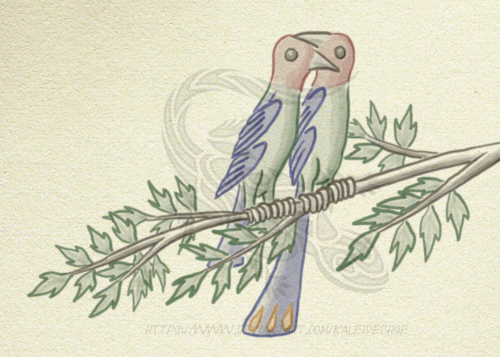Mécóri
A songbird commonly kept as a pet.
Basic Information
Anatomy
Mécóriné are rather small birds with four wings and two legs. There are five toes on each foot, tipped with short claws. The birds have two eyes, no visible ears and a thin, conical beak which is about as long as the head. Their bodies are covered in short feathers, with longer feathers making up the wings and tail.
Biological Traits
The initial plumage is of a dull green. Upon maturity, this green becomes significantly more vibrant.
Furthermore, several body parts take on different colors. The exact coloration varies by breed, but as a general rule, the head is of a reddish color while the wings and tail show shades of blue.
Males also develop notably longer tail feathers which can be up to twice as long as those of the females.
Genetics and Reproduction
Like all known birds on Chryphóra, mécóriné are viviparous. The fledglings become sexually mature about a year after leaving the nest. Approximately three weeks after the mating, the female gives birth to one or two chicks.
Growth Rate & Stages
Newborn chicks are initally naked and need to be kept warm by the parents, or in case of pets, by the owner. It takes about two to three weeks for the plumage to grow. After that, they make their first attempts at flying.
Dietary Needs and Habits
Mécóriné feed on berries and other fruits.
Biological Cycle
Due to being cold-blooded, wild birds go into hibernation during the winter months. Pets are less affected by seasonal changes, but tend to be more sluggish as well.
Additional Information
Social Structure
Mécóriné choose their mate once and stay together for the rest of their lives. In the wild, the young stay with their parents for about two months before they seek out a territory of their own.
Domestication
Young mécóriné are quick to bond with people, especially when they are born in captivity. Chicks that are raised by hand are likely to
become loyal companions to the person caring for them.
In contrast, wild birds captured later in life tend to remain wary of their owners for years.
Regardless of the birds' degree of attachment, it is highly advisable to keep them in a cage and only let them fly freely after making sure that all windows and doors are closed. This is especially true during summer when the heat makes them highly active and mobile.
Uses, Products & Exploitation
These birds are primarily kept for their beautiful singing voice and colorful plumage.
Lifespan
4-5 years (in the wild)
8-12 years (in captivity)
8-12 years (in captivity)
Average Height
12 - 14 cm
Average Weight
90 -110 g
Average Length
17 - 22 cm (without tail)
27 - 35 cm (female including tail)
37 - 45 cm (male including tail)
27 - 35 cm (female including tail)
37 - 45 cm (male including tail)




Comments